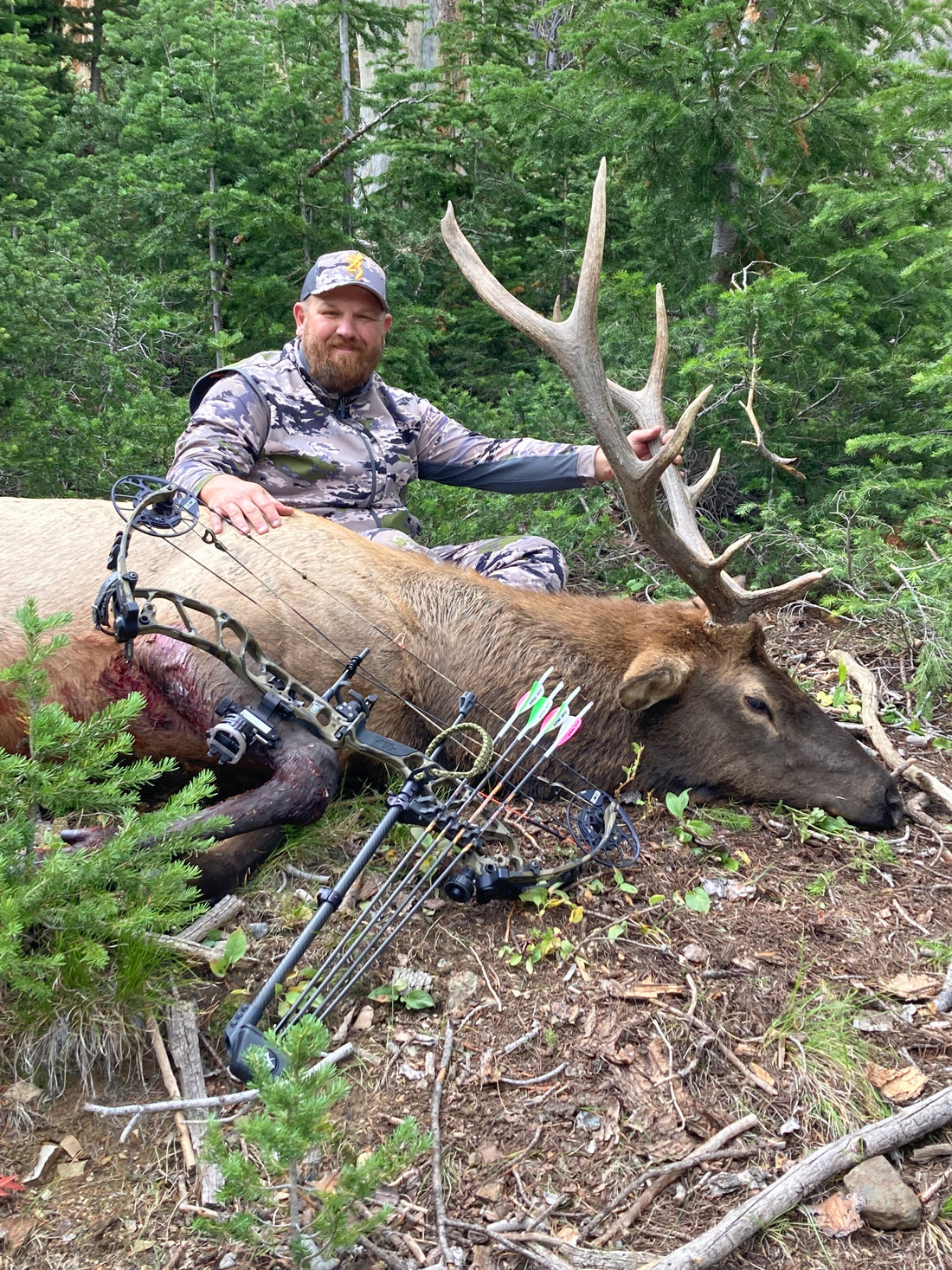
Archery Setups for Elk Season
Zach BowhayI get a lot of questions about elk hunting, but one of the most common is about my archery setup. Of course, this is a personal decision with plenty of room for individual preferences, but I thought I’d go through my current setup and explain why I make the choices I do.

The Bow
Full disclosure: I’ve always been a gear nerd. Growing up with a dad who owned a small archery shop, I developed a love for new bows at an early age. Because of that, I end up with a new bow, or sometimes two, most years. That’s not necessary, and for many people, it can even be counterproductive, especially if you’re not confident tuning a bow or don’t have the time to do it properly.
At 6’2”, I’m a bigger guy, so I prefer a longer axle-to-axle bow, typically in the 33" to 35" range. There are a few reasons for this. First, with a longer draw length, the string angle on shorter bows can get pretty steep, which doesn’t feel as comfortable to me. Second, I’ve got a bigger head, so my peep sits way up the string. On shorter bows, I sometimes run out of room before hitting the cable serving. And most importantly, longer bows tend to be more forgiving. Elk hunting can present shots at a variety of distances, angles, and positions. A more forgiving setup helps when it’s time to make those shots count.

Right now, I’m shooting a Mathews Lift with a 30” draw length at 75 pounds. That brings me to one of the main points I want to address: draw weight. Your draw length is what it is, but poundage is a common question I get. Do you need to shoot 75 pounds to kill an elk? Absolutely not. You should shoot as much weight as you can comfortably draw from any position, without struggling. For me, the Mathews draws smoothly, and 75 pounds feels right. But if you’re only comfortable at 50 pounds, or even less, that’s completely fine. Lower poundage can be offset by the right arrow and broadhead setup, which I’ll cover later.
Sights
One thing I refuse to compromise on is my setup for my sight. It’s not necessarily about the brand; it’s more about the configuration and how it fits my style of elk hunting. Most of my hunting is done in the timber, where shots are typically 50 yards and in. As a result, for the past 15 years or so, I’ve used a sight with three fixed pins and a slider that allows me to dial in exact yardages beyond 50 yards.
I haven’t used a 20-yard pin in years. With my current setup, my 30-yard pin keeps me well within the kill zone on a bull from 0 to 30 yards. If I know it’s a 20-yard shot, I’ll hold a little low, and it’s dead-on, but even if I don’t, it’s still a lethal shot. My fixed pins are set at 30, 40, and 50 yards, which cover me for 99% of the bulls I call in and shoot. At those distances, even if I’m off by a yard or two, it’s not going to matter with fixed pins.
When I’m spot-and-stalk hunting, or just practicing or shooting 3D courses, those longer shots require more precision. That’s where having the option to slide my sight and dial in an exact distance shines.
Rest
These days, most people are running some kind of fall-away rest, although there are still a few who use a biscuit-style rest. Honestly, either one works just fine for elk, and I’ve killed plenty using both. I used to love the simplicity of the biscuit. They’re virtually fail-proof, easy to tune, and surprisingly accurate. I still put them on my wife's and kids’ bows for both target shooting and hunting because I know they won’t have any issues in the field.
I always liked the idea of a fall-away rest, but I never loved the models that attach to your cables. If something went wrong in the elk woods, you were pretty much out of luck. These days, I run a limb-driven rest, and that’s my go-to. The main reason? They’re incredibly accurate, and if something does go wrong, such as the cord coming loose, it’s a simple fix. Just press the launcher arm down, tighten the cord, and you’re back in business.
Balance
I do think having a stabilizer on your bow is a good idea, but some folks go a little overboard with extra-long stabilizers, back bars, side bars, you name it. Sure, all of that can help balance the bow and improve accuracy in theory. But the reality is, I don’t want to lug around a 15-pound bow all over the mountains.

I prefer a simple 8"–10" stabilizer with some weight out front. That setup gives me enough balance and stability without becoming a burden. I’ve also hunted elk quite a bit with the Quivalizer from Option Archery. When I first tried it, I figured it would be awkward in the woods, but it carries and balances well.
That said, for the past couple of years, I’ve been running a standard Bridge-Lock stabilizer, which integrates perfectly with my Mathews bow. I’m not saying you shouldn’t try to balance your bow and strive for accuracy, but if you’re already shooting well without all the extra accessories, I’m not sure it’s worth the weight and complexity in the elk woods.
Quivers
Speaking of quivers, there are a ton of options out there. For years, I used a two-piece design because it bolts close to the bow and offers better balance. The downside? It wasn’t easy to take on and off, which always bugged me.
So, when TightSpot Quivers hit the market years ago, I was more than a little excited. A quiver that fits tightly to the bow but could be easily removed? That was a dream come true.
Since then, quiver designs have continued to improve. These days, I prefer a removable quiver that mounts with two contact points on the bow. This gives me the snug fit and quietness of a two-piece, but also the flexibility to remove it when I’m set up and calling—or when it’s windy and I don’t want my quiver acting like a sail.
Arrows and Broadheads
This might be the most crucial decision you'll make when setting up your bow for elk hunting. You must choose the right arrow spine for your draw length, draw weight, and broadhead weight. Getting this right will make tuning easier and ensure your setup performs well on large-bodied animals like elk.
There’s plenty of solid information available, including arrow charts, tuning guides, and videos. Still, if you're unsure, I highly recommend visiting a local pro shop or consulting with someone who knows what they’re doing. Also, if you’re stuck between two spine choices, I’ve always found it better to err on the side of a stiffer shaft.
Right now, I’m shooting the Easton Axis 4mm in a 300 spine, fletched with Max Stealth vanes. These arrows fly great with my setup, and the vanes are both quiet and accurate.

Broadhead choice is another area that sparks considerable debate. I’ve taken bulls with replaceable-blade heads, cut-on-contact fixed blades (two- and three-blade), and mechanicals. All have worked well, but that doesn’t mean every option is right for everyone. My last several bulls have been taken with the SEVR 1.5 expandable broadhead, and it’s performed excellent for me. I shoot 125-grain broadheads, which not only help with front-of-center balance but also give me a little more punch on impact.
That said, if you're a lower-poundage shooter, I strongly recommend avoiding mechanicals and sticking with cut-on-contact fixed blades. Shot placement is always the most critical factor, but when it comes to elk, your broadhead—and what’s pushing it—needs to be up to the task.
There are different opinions on arrow weight, but I prefer a slightly heavier arrow. My current setup involves shooting a 488-grain arrow at 287 fps, which yields 89.2 foot-pounds of kinetic energy. That’s plenty for elk, and I have complete confidence in its performance.

Closing
At the end of the day, there’s no one-size-fits-all setup for elk hunting with a bow. What works for me might not be the perfect fit for you, and that’s okay. The key is to build a rig you’re confident in, one that fits your body, your shooting style, and the way you hunt. Whether you’re deep in the backcountry or chasing bugles close to the truck, having gear that you trust makes all the difference when the moment of truth comes. Take the time to tune your setup, shoot often, and become familiar with your equipment inside and out. Elk are tough animals, and the mountains are unforgiving, but with a dialed-in bow and solid shooting, you’ll be ready when opportunity knocks.
Zach Bowhay is known as a hunter and writer who has successfully hunted many species all across the western states and beyond. Specifically, he is highly regarded in the western hunting community as an expert in DIY elk hunting on public lands. For 15 years he has been a well-published writer, sharing his love of the outdoors and expertise in both gear and tactics through his writing as well as video and photos. When not spending time with his wife and three kids he can be found roaming the mountains of the west in the pursuit of adventure.
Find him on Instagram
